Who Are the 55 Cleared Guantánamo Prisoners on the List Released by the Obama Administration?

The logo of the "Close Guantánamo" campaign, which began on January 11, 2012, on the 10th anniversary of the opening of the "war on terror" prison at Guantánamo that has done so much to poison America's belief that it is a nation founded on the rule of law.
POSTSCRIPT January 2013: The Center for Constitutional Rights has confirmed that a 56th prisoner was added to this list after its initial drafting — Djamel Ameziane, an Algerian mentioned below.
UPDATE March 14, 2014: Please note that this list of 56 men cleared for release by the Guantánamo Review Task Force (plus 30 other Yemenis cleared for release but held in "conditional detention" until the authorities are satisfied that the security situation in Yemen has improved) reflected the situation at Guantánamo from the time of its publication in October 2012 until August 2013, when two Algerians on the list were released, followed by eight other cleared prisoners in December, and one more in March 2014. I have noted who has been released on the list. As a result of these releases, there are now 76 cleared prisoners (46 plus the 30 Yemenis in "conditional detention"). For a breakdown of who is who (including the identities of the 30 Yemenis in "conditional detention"), see our prisoner list.
By Andy Worthington
On September 21, lawyers for the Guantánamo prisoners -- and others who had been watching Guantánamo closely -- were completely taken by surprise when, as part of a court case, the Justice Department released the names of 55 of the 86 prisoners cleared for release from Guantánamo in 2009 by President Obama’s Guantánamo Review Task Force.
The Task Force was made up of officials and lawyers from all the relevant government departments and from the intelligence agencies, and its final report was issued in January 2010. Of the 166 prisoners still held, 86 of those were recommended for release, but are still held, and the list reveals, for the first time ever, 55 of those names.
Until September 21, the government had refused to publicly identify any of the prisoners cleared for release, stating that it would hinder efforts to resettle them, but -- perhaps because the resettlements have ground to a halt, after 42 prisoners, who couldn't be safely repatriated because of the risk of torture or other ill-treatment, were resettled in 17 countries, or perhaps in an effort to overcome Congressional resistance to releasing prisoners -- the list was released.
What is interesting, of course, is who is on the list. Of the 55 names, 28 are not surprising, as they were included in the exclusive report published here in June this year, entitled, “Guantánamo Scandal: The 40 Prisoners Still Held But Cleared for Release At Least Five Years Ago,” in which I identified 40 prisoners cleared for release under President Bush, between 2004 and 2007, but never freed.
Those cleared under President Bush -- and again by President Obama’s Task Force -- are 13 Yemenis, the last five Tunisians in Guantánamo, three Algerians, a Saudi, Mohammed Tahamuttan (the last Palestinian), Umar Abdulayev (the last Tajik), the last three Uighurs (Muslims from China’s Xinjiang province), and Shaker Aamer, the last British resident in the prison.
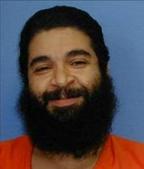
Shaker Aamer, photographed in Guantánamo.
To be strictly accurate, Shaker Aamer's status had not been publicly confirmed before by the U.S. government, although it was common knowledge, but all of the others had their approval for transfer out of Guantánamo confirmed in a variety of documents -- in particular, in the classified military files released last year by WikiLeaks, and also in the outcomes of military review boards that were made publicly available by the Pentagon.
Of the 27 prisoners not originally cleared under President Bush, 13 are Yemenis, four are Syrians, four are Afghans, and one each are from Algeria, Libya, Mauritania, Morocco, Sudan and the United Arab Emirates.
In a further indictment of the behavior of the Obama administration, it should be noted that nine of the 55 men on the list had their habeas corpus petitions turned down by judges -- seven by District Court judges, and two by the D.C. Circuit Court (the Court of Appeals) after their habeas corpus petitions had been granted by District Court judges. Most of those who had their petitions turned down had fallen victim to the right-wing judges of the D.C. Circuit Court, who had rewritten the rules, after 38 prisoners had their petitions granted (and the majority were released), insisting that the shoddy submissions put forward in case after case by the government should, in defiance of common sense and justice and fairness, be given the presumption of accuracy.
This was disgraceful, of course, and it was also disgraceful that, in June this year, when presented with the opportunity to do something about it, the Supreme Court chose not to. However, in most of these cases, the principal blame lies with the Obama administration, as, although DoJ lawyers were informed of the decisions taken by the Task Force, no mechanism was put in place to ensure that cleared prisoners did not have their habeas petitions challenged by the government. That would have made sense, but as with so much to do with Guantánamo, the reality was a mess.
For 26 of these men, the problem has been that they are Yemenis, and, disgracefully, after a Nigerian named Umar Farouk Abdulmutallab, recruited in Yemen, tried and failed to blow up a plane bound for Detroit with a bomb in his underwear on Christmas Day 2009, President Obama responded to a wave of hysteria by announcing a moratorium on releasing any cleared Yemenis from Guantánamo, which was meant to be a temporary measure, but which still stands nearly three years later.
Many of the other men await new homes -- the three Uighurs, the four Algerians, the Palestinian, the Tajik, and the four Syrians, and probably the Moroccan and possibly the Mauritanian -- although others could be released tomorrow.
Shaker Aamer, for example, whose continued detention is an indictment of the disdain for the prisoners at the highest levels of the British and American governments, should be freed immediately, as our exclusive article two weeks ago made clear, to rejoin his British wife and children in the U.K., and the five remaining Tunisians should also be sent home. They had all opposed the dictatorship of Zine El-Abidine Ben Ali, and had been subjected to show trials in absentia, but with Ben Ali deposed, nearly two years ago, their return also ought to be straightforward.
In addition, it ought to be possible for the four Afghans and the men from Sudan and the United Arab Emirates to be returned home.
Below are the names of 27 prisoners cleared for release under President Obama, with brief explanations of some of their stories, followed by the names of the 28 men who were first cleared under President Bush, and have now been cleared for release again under President Obama. It should hardly need adding that all of these men should be freed as soon as possible, as their continued detention makes a mockery of the processes established to determine who should be released, and who should continue to be held, as well as undermining any claims by the U.S. government that Guantánamo is anything other than the legal black hole that it was when it was first established nearly eleven years ago.
The 27 prisoners cleared for release under President Obama
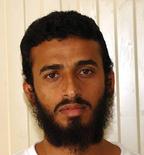
Idris Ahmad Abdu Qadir Idris, photographed in Guantánamo.
Idris Ahmad Abdu Qadir Idris (ISN 35, Yemen)
Fayiz Ahmad Yahia Suleiman (ISN 153, Yemen)
Sharif Al-Sanani (ISN 170, Yemen)
Muhammed Ali Husayn Khunaina (ISN 254, Yemen)
The first of the 26 Yemenis on the list of 55 prisoners, these four men were seized in December 2001, on or around the border between Afghanistan and Pakistan, and have now been held for longer than the First World War and the Second World War combined. Like all the cleared Yemenis, they should be released immediately.
Ibrahim Othman Ibrahim Idris (ISN 36, Sudan) RELEASED DEC. 2013
Salem Gherebi (ISN 189, Libya)
Younous Chekkouri (ISN 197, Morocco)
Muieen Adeen Al-Sattar (ISN 309, UAE)
These four men were also seized in December 2001, on or around the border between Afghanistan and Pakistan, and should be released immediately. Idris can be returned to Sudan, to join the ten other Sudanese prisoners freed without any problems, and Salem Gherebi, incorrectly listed as Falen Gherebi, a 51-year old opponent of the regime of Muammar Gaddafi, can be released to Libya, now that the wild allegations against him -- involving international travel and jihad -- have been discarded and Gaddafi is dead.
Of the other two, little is known of al-Sattar, apparently born in Dubai in 1975, as he has persistently refused legal representation. On October 23, 2009 U.S. District Judge John D. Bates dismissed a habeas corpus petition filed on his behalf, because, as he stated, "Al-Sattar has given no indication during the almost three-year pendency of his case that he wishes this habeas action to proceed" and "has unequivocally rejected representation."
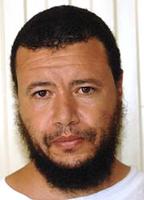
Younous Chekkouri (aka Younis Chekhouri), photographed in Guantánamo.
Much more is known about Younous Chekkouri (aka Younis Chekhouri), who is represented by lawyers at the London-based legal action charity Reprieve. The 44-year old Moroccan, an eloquent man whose long detention has seen him persistently marked out as a model prisoner, had been in Afghanistan with his wife, working on the outskirts of Kabul for a charity that helped many of the young Moroccans who had left their homeland, either because of persecution or because of a lack of opportunities. As his lawyers at Reprieve have explained, "Younous has consistently been one of the most cooperative, peaceful prisoners at the base; he says he bears Americans no ill-will. His greatest wish is to be reunited with his wife and continue with the quiet life that was interrupted by America's 'war on terror.'"
Ahmed Adnan Ahjam (ISN 326, Syria)
Ali Al-Shaaban (ISN 327, Syria)
Abdul Hadi Omar Mahmoud Faraj (ISN 329, Syria)
These three men were captured with a fourth Syrian, Maasoum Abdah Mouhammad, who was rehoused in Bulgaria in May 2010. All four had basically ended up in Afghanistan as economic migrants, and it seems certain, therefore, that new homes were sought for them along with Maasoum Mouhammad, but were not forthcoming in their cases. Renewed efforts must be undertaken to rehouse them, and, if it is not possible to return them to Syria, then they should be given new homes in the U.S.
Jalal Bin Amer Awad (ISN 564, Yemen)
Sabry Mohammed (aka Al-Qurashi) (ISN 570, Yemen)
Hamood Abdullah Hamood (aka Al-Wady) (ISN 574, Yemen) RELEASED IN SAUDI ARABIA DEC. 2013
Saad Nasir Mukbl Al-Azani (ISN 575, Yemen)
These four Yemenis were seized in house raids in Karachi, in Pakistan, on and around February 7, 2002, when 15 men in total were seized, five of whom -- a Russian, a Saudi, two Kuwaitis and a British citizen -- were freed between 2004 and 2007. Two other Yemenis seized in these raids are amongst the 28 prisoners initially cleared for release under President Bush. Of the four, two are clients of Killmer, Lane & Newman in Denver, Colorado, and, as I explained in an article in February 2011, "The 11-Year Old American Girl Who Knows More About Guantánamo Than Most U.S. Lawmakers," when Sammie Killmer, the 11-year old daughter of one of the lawyers, Darold Killmer, wrote about Guantánamo for a school project, and came up with short descriptions for each of her father's firm's clients, which were wonderfully descriptive. Sammie was told that Jalal "talks very fast and likes pictures of very beautiful animals," and that Saad "is very religious and studies religion" and "is shy and quiet."
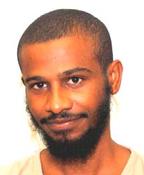
Emad Hassan, photographed in Guantánamo.
Emad Abdallah Hassan (ISN 680, Yemen)
Abdel Ghaib Ahmad Hakim (ISN 686, Yemen)
Mohammed Ahmed Salam Al-Khateeb (ISN 689, Yemen)
Abdul Qader Ahmed Hussein (ISN 690, Yemen)
He had his habeas corpus petition denied in October 2011.
Mohammed Al-Zarnouqi (ISN 691, Yemen)
These five Yemenis were seized in a house raid in Faisalabad, in Pakistan, on March 28, 2002, on the same night that the alleged "high-value detainee" Abu Zubaydah -- actually the mentally damaged gatekeeper of a training camp that was not aligned with al-Qaeda -- was seized in another part of town. 15 men were seized in the raid, five of whom -- a Saudi and four Yemenis -- have been released, two after having their habeas corpus petitions granted. Another man, sadly, was one of the three prisoners who died at Guantánamo, in mysterious circumstances, in June 2006. One of the other men, Mohammed Tahamuttan, is a Palestinian, and is amongst the 28 prisoners initially cleared for release under President Bush.
Jihad Dhiab (ISN 722, Syria)
Ahmed Abdel Aziz (ISN 757, Mauritania)
Belkacem Bensayah (ISN 10001, Algeria) RELEASED DEC. 2013
He had his habeas corpus petition denied in November 2008, although that ruling was vacated on appeal in June 2010.
Of these three men, Jihad Dhiab and Ahmed Abdel Aziz were seized in 2002 in Pakistan, far from the battlefields of Afghanistan, at a time when many dozens of foreigners -- most of whom have now been released -- were rounded up in Pakistan and sold by the Pakistani authorities to U.S. forces. 42-year old Ahmed Abdel Aziz, seized on June 25, 2012, is an educated and articulate man. He studied literature and philosophy, and speaks French and English, in addition to Arabic, and he was an Arabic language teacher at the time of his capture. 41-year old Jihad Dhiab, also known as Abu Wa'el Dhiab, was born in Lebanon but moved to Syria when he was a child. As an adult, however, after marrying, he found it impossible to find work, and moved, with his wife and children, to Pakistan and then Afghanistan, where, as his lawyers at Reprieve explained, after Syrian friends helped the family to get established, he "opened a food import business, mainly selling honey." After 9/11, however, the family had to leave, and settled in Lahore, where, opportunistically, he was seized on April 1, 2012. Tragically, his health has deteriorated significantly in Guantánamo, and he is currently confined to a wheelchair. He is also profoundly depressed.
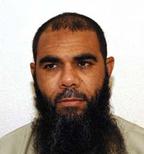
Belkacem Bensayah, photographed in Guantánamo.
Belkacem Bensayah, on the other hand, is the last of six Algerians who had been living in Bosnia-Herzegovina since the 1992-95 war and had married local women, and who, after 9/11, were picked up after the U.S. exerted pressure on the Bosnian government and imprisoned for three months. When the Bosnian authorities found no evidence of a supposed plot to blow up the U.S. embassy in Sarajevo and released the men in January 2002, they were immediately kidnapped by U.S. operatives and rendered to Guantánamo. In November 2008, five of the men had their habeas corpus petitions granted by US Federal Judge Richard Leon, but Bensayah's petition was refused. However, in June 2010, the D.C. Circuit Court (the Court of Appeals) found no evidence of wrongdoing on his part, and vacated Judge Leon's ruling. Like many others, he awaits a new home, his long ordeal should be brought to an end, as his five compatriots, who had their habeas petitions granted four years ago, have all been freed.
Shawali Khan (ISN 899, Afghanistan)
He had his habeas corpus petition denied in September 2010.
Khiali Gul (ISN 928, Afghanistan)
Abdul Ghani (ISN 934, Afghanistan)
Mohammad Zahir (ISN 1103, Afghanistan)
These four Afghans should be returned home immediately. I have already discussed at length the profound injustice of holding Shawali Khan and Abdul Ghani, in this article and in another here, and noted how their cases discredit America, as Khan, against whom no evidence of wrongdoing exists, nevertheless had his habeas corpus petition denied, and Ghani, a thoroughly insignificant scrap metal merchant, was put forward for a trial by military commission -- a war crimes trial -- under President Bush.
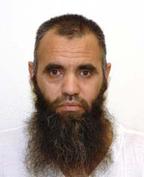
Khiali Gul (aka Khi Ali Gul), photographed in Guantánamo.
To these injustices can be added those against Khiali Gul (aka Khi Ali Gul) and Mohammad Zahir. Gul, who was accused of taking part in a bomb plot and being part of a Taliban assassination team, has always maintained that he fought with U.S. forces in Tora Bora, and was captured because enemies of his told lies about him to US forces (as happened in far too many cases), and Zahir, accused of being employed by the Taliban in intelligence, has always maintained that he was a teacher.
The 28 prisoners cleared for release under President Bush and President Obama
Al-Khadr Abdallah Muhammad Al-Yafi (ISN 34, Yemen)
Asim Thabit Abdullah Al-Khalaqi (ISN 152, Yemen)
Khalid Abd Elgabar Mohammed Othman (ISN 163, Yemen)
Mahmoud Al-Shubati (ISN 224, Yemen)
Mohammed Abdullah Mohammed Ba Odah (ISN 249, Yemen)
Said Muhammad Salih Hatim (ISN 255, Yemen)
He had his habeas corpus petition granted in December 2009, but vacated on appeal in February 2011.
Fadhel Hussein Saleh Hentif (ISN 259, Yemen)
He had his habeas corpus petition denied in August 2011.
Suleiman Awadh Bin Aqil Al-Nahdi (ISN 511, Yemen)
He had his habeas corpus petition denied in February 2010.
Abdulkhaliq Ahmed Al-Baidhani (ISN 553, Yemen)
Fahmi Salem Al-Assani (ISN 554, Yemen)
He had his habeas corpus petition denied in February 2010.
Mansour Mohamed Mutaya Ali (ISN 566, Yemen)
Saleh Mohammad Seleh Al-Thabbi (ISN 572, Yemen)
Hussain Salem Mohammad Almerfedi (ISN 1015, Yemen)
He had his habeas corpus petition granted in July 2010, but reversed on appeal in June 2011.
Of these 13 Yemenis, all but one -- identified as Saleh al-Thabbi, although his correct name is Saleh al-Zabe -- were cleared for release under President Bush in 2006 and 2007. Al-Zabe, shamefully, was cleared for release in September 2004. Five of the men, as noted, had their habeas corpus petitions denied, either by the District Court, or by the D.C. Circuit Court (the Court of Appeals), and, in addition, Mansour Ali and Saleh al-Thabbi were seized in house raids in Pakistan on February 7, 2002, along with the four other men identified above.
Ridah Bin Saleh Al-Yazidi (ISN 38, Tunisia)
Adel Al-Hakeemy (ISN 168, Tunisia)
Hisham Sliti (ISN 174, Tunisia)
He had his habeas corpus petition denied in December 2008.
Abdul Bin Mohammed Ourgy (ISN 502, Tunisia)
Mohammed Abdul Rahman (ISN 894, Tunisia)
For the last five Tunisians in Guantánamo, there is no credible obstacle to their release, and the new government is actively seeking their repatriation, as I discussed in an article in July. Noticeably, one of these men, Mohammed Abdul Rahman (also known as Lotfi bin Ali), who was first cleared in 2004, is also ill, as I explained in the report on the 40 cleared prisoners in June:
In the classified US military files relating to the Guantánamo prisoners, which were released by WikiLeaks in April 2011, Abdul Rahman’s file was a “Recommendation to Release or Transfer to the Control of Another Country for Continued Detention (TR),” dated June 27, 2004, in which it was also noted that he “had a mechanical heart valve placed in 1999,” and “has chronic problems with his heart rhythm (atrial fibrillation),” and also “has a history of kidney stones, latent tuberculosis, depression and high blood pressure. He is also on chronic anticoagulation (blood thinners).”
Saad Al-Qahtani (ISN 200, Saudi Arabia) RELEASED DEC. 2013
Shaker Aamer (ISN 239, UK)
Omar Hamzayavich Abdulayev (ISN 257, Tajikistan)
Mohammed Abdullah Taha Mattan (ISN 684, Palestine)
Saad al-Qahtani and Shaker Aamer could -- and should -- be released tomorrow. However, for Omar Abdulayev, the last Tajik, and Mohammed Taha Muttan (generally spelt Tahamuttan), new countries are needed that would be prepared to offer them a new home. Discussions have actually been taking place for several years, as Omar Abdulayev (generally known as Umar Abdulayev) was eligible for release in 2009, when the government refused to defend his ongoing detention in court, and Tahamuttan (seized in the house raid in Faisalabad in March 2002, with the five Yemenis mentioned above) was almost given a new home in Germany, along with two other men, in September 2010, although his resettlement was dropped for domestic political reasons. If new homes cannot be found for these two men, they should be rehoused in the U.S.
Nabil Said Hadjarab (ISN 238, Algeria) RELEASED AUG. 2013
Motai Saib (Mutia Sayyab) (ISN 288, Algeria) RELEASED AUG. 2013
Ahmed Bin Saleh Bel Bacha (Belbacha) (ISN 290, Algeria) RELEASED MAR. 2014
The Algerians, long cleared for release, fear repatriation, and with good reason, as Algeria remains a closed regime with a unhealthy human rights record. I covered Nabil Hadjarab's story here and in a follow-up here, and also covered Ahmed Bel Bacha's story here, referring to him, as he is more commonly known, as Ahmed Belbacha. Motai Saib's case was briefly discussed here. As with the men above, If new homes cannot be found for them, they should be rehoused in the U.S.
Abdul Sabour (ISN 275, China) RELEASED IN SLOVAKIA DEC. 2013
Khalid Ali (ISN 280, China) RELEASED IN SLOVAKIA DEC. 2013
Sabir Osman (ISN 282, China) RELEASED IN SLOVAKIA DEC. 2013
The Chinese prisoners, the Uighurs, have also long been cleared for release, and had their habeas corpus petitions granted, along with 14 of their compatriots, in October 2008. The other men were rehoused in Bermuda, Palau, Switzerland and El Salvador between June 2009 and April this year, but these three men are still stranded. As with the men above, If new homes cannot be found for them, they should be rehoused in the U.S., as I discussed here, in an article in which I also drew on a demand for their release in the US that was published as an editorial in the Washington Post.
ADDED TO THE LIST AFTER PUBLICATION: Djamel Ameziane (ISN 310, Algeria) RELEASED DEC. 2013
In addition to the 55 men on the list released on September 21, 32 other prisoners were approved for transfer out of Guantánamo, although 30 of these men were Yemenis, and subject to what the Task Force described as "conditional detention," a term that officials invented, and which is supposedly dependent upon a perceived improvement in the security situation in Yemen.
The identities of these 32 men remain classified, and it is difficult to assess whether they include any of the twelve other men cleared for release who were identified in our report in June, with, it should be noted, one particularly depressing exception. That man is Adnan Farhan Abdul Latif (ISN 156), who died in Guantánamo last month, even though he had received a “Recommendation for Transfer Out of DoD Control," signed by the commander of Guantánamo on December 18, 2006 -- in other words, four years and nine months before he died. As Jason Leopold noted in a powerful article about Adnan Latif for Truthout last week, when President Obama's Guantánamo Review Task Force issued its report recommending which prisoners should be released, "Adnan was one of them. But only his attorneys knew about it. The information was deemed 'protected,' meaning they could not discuss it publicly."
His terrible and unforgivable death, more than anything else, ought to be the spur to the release of all the cleared prisoners mentioned above.
Note: The 11 other prisoners included in my report in June, who were not on the list of 55 prisoners released by the government is September, are as follows: Fahed Ghazi (ISN 26, Yemen), Abdul Rahman Naser (ISN 115, Yemen), Said Al-Busayss (ISN 165, Yemen), Ali Yahya Al-Raimi (ISN 167, Yemen), Mahmoud Bin Atef (ISN 202, Yemen), Mohammed Bin Salem (ISN 251, Yemen), Djamel Ameziane (ISN 310, Algeria), Mohammed Bawazir (ISN 440, Yemen), Abdul Rahman Al-Qyati (ISN 461, Yemen), Khalid Al Dhuby (ISN 506, Yemen), and Tariq El-Sawah (ISN 535, Egypt). Please also note that many others not mentioned are also wrongly regarded as constituting some sort of a threat, when that is clearly not the case -- the last two Kuwaitis, Fayiz al-Kandari and Fawzi al-Odah, for example, and Obaidullah, another insignificant Afghan prisoner.
To demand the release of these prisoners, and the 31 others cleared for release who have not been identified, please write to: Secretary of State Hillary Clinton, U.S. Department of State, 2201 C Street NW, Washington D.C. 20520.




